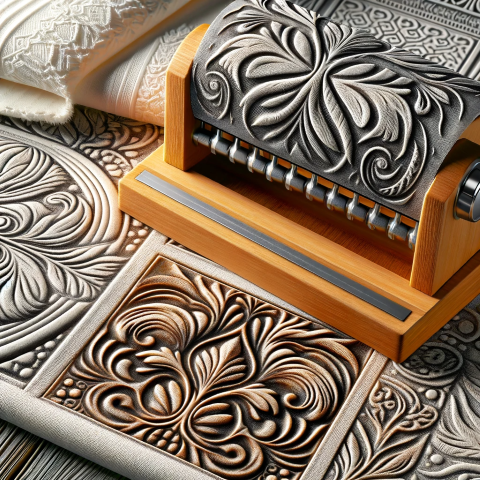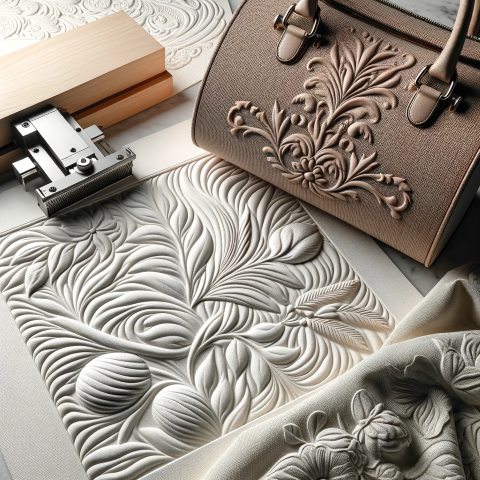Last Updated on: 24-Jan-2024 (6 months, 3 days ago)
Share on Facebook • Share on Twitter
The process of embossing typically involves the use of a stamp or mold that is pressed into the surface of the material. The stamp or mold is heated and then applied to the material using pressure, causing the material to conform to the shape of the stamp or mold. The resulting pattern is then cooled and set, creating a raised design on the surface of the material.
Embossing can be done on a variety of materials, including leather, vinyl, fabric, and paper. The type of material used will affect the final result, with some materials creating a more subtle embossed pattern than others.
One common application of embossing in textiles is in the production of leather goods, such as belts, handbags, and shoes. Leather can be embossed with a variety of patterns, from simple geometric shapes to intricate floral designs. The resulting texture adds depth and interest to the leather, creating a unique and visually appealing product.
Embossing can also be used in the production of fabric products, such as upholstery and drapery. Textiles can be embossed with a variety of patterns and textures, including floral, geometric, and abstract designs. The resulting texture can add visual interest to a space, creating a unique and luxurious look.
Embossing can also be used to create custom designs on textile products. Custom embossing can be used to create personalized clothing items, accessories, and home decor items, allowing for a unique and one-of-a-kind product.
Another variation of embossing is blind embossing, which involves pressing a design into the surface of the material without the use of color or foil. This creates a subtle, textured pattern that adds depth and interest to the material. Blind embossing is often used in the production of stationery and other paper products, as well as in the production of leather goods.
Overall, embossing is a versatile technique that can be used to add texture and interest to a wide range of textile products. Whether used in the production of leather goods, fabric products, or custom designs, embossing can create a unique and visually appealing result that adds depth and dimension to any product.
�A calendaring process which produces a raised design or pattern in relief. The design is pressed into fabric or leather by passing it through hot engraved rollers; velvet or plush is embossed by shearing the pile to different levels or by pressing parts flat.
Some more terms:
Gingham
A medium-weight, plain-weave fabric with a plaid or check pattern made from cotton or synthetics fibers. The word is derived from Italian 'Ging-gang' meaning 'striped'. Medium or fine yarns of...
Read about GinghamPoint turner
A point turner is a tool used in sewing to create crisp and clean corners on fabric. It is typically made of plastic or wood, and is shaped like a small stick with a pointed end and a flat end. The...
Read about Point turnerPlied Yarn: The Twisted Tale of Durability and Versatility
A yarn composed of two or more single yarns twisted together. Many two-ply yarns are used in carpet. In cut-pile carpet, eg, saxony, plied yarns must be heat-set to prevent untwisting under traffic....
Read about Plied YarnBird's Eye
Three types: (1) A clear-finish worsted fabric woven to produce smallindentations suggesting the eye of a bird. (2) Also known as Diaper Cloth. Fabric woven on a dobby loom ofcardedyarns in tiny...
Read about Bird's EyeCloudiness
a) In a weft-knitted fabric, a defect that consists of ill-defined areas of varying density attributable to the use of yarn of irregular thickness. b) In webs and slivers, a defect that consists of...
Read about CloudinessFaux Linen Secrets: Explore the Revolutionary Blend of Fashion & Function
Faux Linen, also known as imitation linen, is a fabric that replicates the appearance and texture of natural linen but is actually made from synthetic fibers or a blend of natural and synthetic...
Read about Faux linenMarble Cloth
Marble cloth, also known as marbled fabric or marbleized textile, is a unique type of textile that mimics the appearance of marble stone. It is characterized by swirling patterns and a marbled...
Read about Marble ClothSolid wood
In textile manufacturing, "solid wood" refers to the use of genuine, natural wood as a raw material in the production of textiles. Solid wood textiles are characterized by their unique texture,...
Read about Solid woodAdd a definition
- The term you want to define
- Its definition in 500 words or less
- Attach an image if necessary.
- Optionally, tell us about yourself in 200 words or less!
Companies for Embossing:
- Company name
- Company address
- Attach a logo, if necessary.
- Optionally, tell us about yourself in 200 words or less!

 The Turkish textile industry has a rich tradition of craftsmanship and innovation.
The Turkish textile industry has a rich tradition of craftsmanship and innovation.

